From February 24, 2005:

The above three-part image may be viewed as a tribute to
Jerusalem Day (today), to Saul Bass, or to Spider Jerusalem.
(See related posts and Damnation Morning.)
From February 24, 2005:

The above three-part image may be viewed as a tribute to
Jerusalem Day (today), to Saul Bass, or to Spider Jerusalem.
(See related posts and Damnation Morning.)
Or: Ready When You Are, C. B.
Dennis McLellan, Special to The Los Angeles Times , May 7, 2013:
Born in Los Angeles on June 29, 1920, Harryhausen was 13
when he saw "King Kong" during its run at Grauman's Chinese
Theater in Hollywood.
"I haven't been the same since," he is repeatedly quoted
as saying over the years.
"I came out of the theater awestruck," Harryhausen elaborated
in a 1999 interview with the Chicago Tribune. "It was such a
totally different, unusual film. The story line led you from the
mundane world into the most outrageous fantasy that's ever
been put on the screen."
For Jerusalem Day
"There are interesting correspondences between
Jewish Kabbala, Torah, and Talmud, and
Chinese Buddhism and Taoism…."
See also Chinese Checkers in this journal.
Structure vs. Character continued…
|
Structure |
|
Related vocabulary:
Nick Tosches on the German word “Quell “
* The title is from Heidegger.
"… Reality is not a given whole. An understanding of this,
a respect for the contingent, is essential to imagination
as opposed to fantasy. Our sense of form, which is an
aspect of our desire for consolation, can be a danger to
our sense of reality as a rich receding background.
Against the consolations of form, the clean crystalline
work, the simplified fantasy-myth, we must pit the
destructive power of the now so unfashionable naturalistic
idea of character.
Real people are destructive of myth, contingency is
destructive of fantasy and opens the way for imagination.
Think of the Russians, those great masters of the contingent.
Too much contingency of course may turn art into journalism.
But since reality is incomplete, art must not be too much
afraid of incompleteness. Literature must always represent a
battle between real people and images; and what it requires
now is a much stronger and more complex conception of the
former."
— Iris Murdoch, January 1961, "Against Dryness"
For the Church of St. Frank:
See Strange Correspondences and Eightfold Geometry.
Correspondences , by Steven H. Cullinane, August 6, 2011
“The rest is the madness of art.”
For the Church of St. Frank:

The phrase “Church of St. Frank” was coined in 1995 by
a Harvard professor sneering at literary critic Frank Kermode.
(See a related Log24 note from 1995.)
Now that Frank Kermode is gone, perhaps the phrase suits Frank Langella.

Above: Langella at Cannes with fellow actors from
Wall Street: Money Never Sleeps . He also starred in
the film version of Starting Out in the Evening (quoted above).
Some related reflections on character:
Diamond Speech (this journal, July 3, 2012) and
Robert Diamond’s Next Life in today’s online New York Times .
"There is such a thing as a tesseract." —A novel from Crosswicks
Related material from a 1905 graduate of Princeton,
"The 3-Space PG(3,2) and Its Group," is now available
at Internet Archive (1 download thus far).
The 3-space paper is relevant because of the
connection of the group it describes to the
"super, overarching" group of the tesseract.
Harvard Gazette , March 4th, 2013:
"Winfrey will speak on May 30 during Commencement day’s
Afternoon Exercises, which serve as the annual meeting of
the Harvard Alumni Association. The exercises will take place
in the Tercentenary Theatre of Harvard Yard,
between Memorial Church and Widener Library."
On the 1977 Octavia Butler novel Mind of My Mind :
"The first chapter in a history that Butler has already taken up
at a much later stage in Patternmaster (1976).
Mind of My Mind begins with Doro, a ruthless mutant
as old as the pyramids who has spent the last 4,000 years
trying to breed a race in his own image. The culminating
experiment is his daughter Mary. But, to Doro's astonishment,
Mary's first instinct on attaining her full powers is to begin
building a mental community— a Pattern— out of the
wretched thousands of Doro's half-telepathic failures
and partial successes. Despite some ragged moments,
Butler is clearly on to a promising vein— something like
Zenna Henderson's 'People' stories without their
saccharine silliness. There's a lot of intrinsic energy in the
Pattern idea, and one wants to see where this erratic, gifted
storyteller will pick it up next."
— Kirkus Reviews , Vol. XLV, No. 8 (1977), p. 453.
See this journal on Butler's dies natalis , the feast of St. Matthias, 2006.
Those who prefer Eastern approaches to religion may consult
Robert Thurman and his daughter Uma.
"Oprah, Uma. Uma, Oprah." — David Letterman
A Nested Sequence of Complete N-points and Their Sections
The complete space 6-point
(6 points in general position in space,
5 lines on each point, and 15 lines, 2 points on each)
has as a section
the large Desargues configuration
(15 points, 4 lines on each, and 20 lines, 3 points on each).
(Veblen and Young, Vol. 1, exercise 11, p. 53)
The large Desargues configuration may in turn be viewed as
the complete space 5-point
(5 points, 4 lines on each, and 10 lines, 2 points on each)
together with its section
the Desargues configuration
(10 points, 3 lines on each, and 10 lines, 3 points on each).
(Veblen and Young, Vol. I, pages 40-42)

The Desargues configuration may in turn be viewed as
the complete space 4-point (tetrahedron)
(4 points, 3 lines on each, and 6 lines, 2 points on each)
together with its section
the complete (plane) 4-side (complete quadrilateral)
(6 points, 2 lines on each, and 4 lines, 3 points on each).
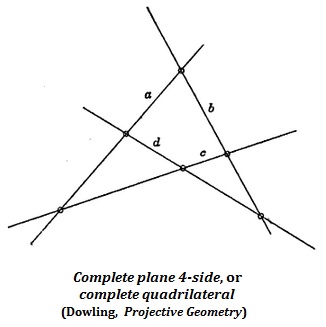
The complete quadrilateral may in turn be viewed as
the complete 3-point (triangle)
(3 points, 2 lines on each, and 3 lines, 2 points on each)
together with its section
the three-point line
(3 points, 1 line on each, and 1 line, 3 points on the line).
The three-point line may in turn be viewed as
the complete 2-point
(2 points, 1 line on each, and 1 line with 2 points on the line)
together with its section
the complete 1-point
(1 point and 0 lines).
Update of May 1: For related material, see the exercises at the end of Ch. II
in Veblen and Young's Projective Geometry, Vol. I (Ginn, 1910). For instance:

Found this morning in a search:
A logline is a one-sentence summary of your script.
www.scriptologist.com/Magazine/Tips/Logline/logline.html
It's the short blurb in TV guides that tells you what a movie
is about and helps you decide if you're interested …
The search was suggested by a screenwriting weblog post,
"Loglines: WHAT are you doing?".
What is your story about?
No, seriously, WHAT are you writing about?
Who are the characters? What happens to them?
Where does it take place? What’s the theme?
What’s the style? There are nearly a million
little questions to answer when you set out
to tell a story. But it all starts with one
super, overarching question.
What are you writing about? This is the first
big idea that we pull out of the ether, sometimes
before we even have any characters.
What is your story about?
The screenwriting post was found in an earlier search for
the highlighted phrase.
The screenwriting post was dated December 15, 2009.
What I am doing now is checking for synchronicity.
This weblog on December 15, 2009, had a post
titled A Christmas Carol. That post referred to my 1976
monograph titled Diamond Theory .
I guess the script I'm summarizing right now is about
the heart of that theory, a group of 322,560 permutations
that preserve the symmetry of a family of graphic designs.
For that group in action, see the Diamond 16 Puzzle.
The "super overarching" phrase was used to describe
this same group in a different context:
This is from "Mathieu Moonshine," a webpage by Anne Taormina.
A logline summarizing my approach to that group:
Finite projective geometry explains
the surprising symmetry properties
of some simple graphic designs—
found, for instance, in quilts.
The story thus summarized is perhaps not destined for movie greatness.
For Poetry Month:
See posts containing
the above image.
“The theory of poetry, that is to say,
the total of the theories of poetry,
often seems to become in time
a mystical theology or, more simply,
a mystique."
Wallace Stevens, The Necessary Angel
… And the history of geometry —
Desargues, Pascal, Brianchon and Galois
in the light of complete n-points in space.
(Rewritten for clarity at about 10 AM ET April 29, with quote from Dowling added.
Updated with a reference to a Veblen and Young exercise (on p. 53) on April 30.)
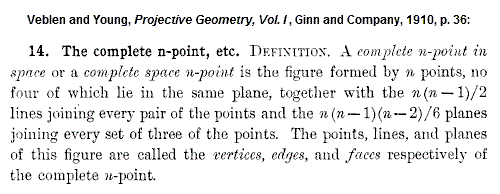

Veblen and Young, Projective Geometry, Vol. I ,
Ginn and Company, 1910, page 39:
"The Desargues configuration. A very important configuration
is obtained by taking the plane section of a complete space five-point."

Each of figures 14 and 15 above has 15 points and 20 lines.
The Desargues configuration within each figure is denoted by
10 white points and 10 solid lines, with 3 points on each line and
3 lines on each point. Black points and dashed lines indicate the
complete space five-point and lines connecting it to the plane section
containing the Desargues configuration.
In a 1915 University of Chicago doctoral thesis, Archibald Henderson
used a complete space six -point to construct a configuration of
15 points and 20 lines in the context not of Desargues ' theorem, but
rather of Brianchon 's theorem and of the Pascal hexagram.
Henderson's 1915 configuration is, it turns out, isomorphic to that of
the 15 points and 20 lines in the configuration constructed via a
complete space five -point five years earlier by Veblen and Young.
(See, in Veblen and Young's 1910 Vol. I, exercise 11, page 53:
"A plane section of a 6-point in space can be considered as
3 triangles perspective in pairs from 3 collinear points with
corresponding sides meeting in 3 collinear points." This is the
large Desargues configuration. See Classical Geometry in Light of
Galois Geometry.)
For this large Desargues configuration see April 19.
For Henderson's complete six –point, see The Six-Set (April 23).
That post ends with figures relating the large Desargues configuration
to the Galois geometry PG(3,2) that underlies the Curtis
Miracle Octad Generator and the large Mathieu group M24 —
See also Note on the MOG Correspondence from April 25, 2013.
That correspondence was also discussed in a note 28 years ago, on this date in 1985.
See Snakes on a Projective Plane by Andrew Spann (Sept. 26, 2006):
Click image for some related posts.
"…what he was trying to get across was not that he was the Soldier of a Power that was fighting across all of time to change history, but simply that we men were creatures with imaginations and it was our highest duty to try to tell what it was really like to live in other times and places and bodies. Once he said to me, 'The growth of consciousness is everything… the seed of awareness sending its roots across space and time. But it can grow in so many ways, spinning its web from mind to mind like the spider or burrowing into the unconscious darkness like the snake. The biggest wars are the wars of thought.' "
— Fritz Leiber, Changewar , page 22
… For the Harvard Arts Weekend:
"Grids, You Say?" by Josefine Lyche, with
Lyche's quotation from Rosalind Krauss in October
(Vol. 9, Summer 1979) —
 |
See also last evening's Elevation of the Host, with Vampire Weekend.
"For every kind of vampire, there is a kind of cross." — Gravity's Rainbow
 |
Let's do the twist. The image at left See this journal |
A phrase from yesterday's noon post:
Sinking the Magic 8-Ball .
A scene from the above film is related to this phrase.
Another image from the film poster:

A review of the film:
"The final 'twist' seems to negate the entire story,
like a bad shaggy-dog joke."
Such a joke:
“Words and numbers are of equal value,
for, in the cloak of knowledge,
one is warp and the other woof.”
— The princesses Rhyme and Reason
in The Phantom Tollbooth
"A core component in the construction
is a 3-dimensional vector space V over F2 ."
— Page 29 of "A twist in the M24 moonshine story,"
by Anne Taormina and Katrin Wendland.
(Submitted to the arXiv on 13 Mar 2013.)
The number of points in such a space is, of course, 8.
The title is a reference to a scheduled SNL.
Related material:
Cooper Union Borg, Master Class, and…
See also today's noon post and The Sunshine Girls.
“Fact and fiction weave in and out of novels like a shell game.” —R.B. Kitaj
Not just novels.
Fact:
The mark preceding A8 in the above denotes the semidirect product.
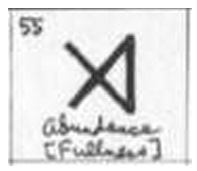 |
Symbol from the box-style I Ching (Cullinane, 1/6/89). This is Hexagram 55, “Abundance [Fullness].” |
The mathematical quote, from last evening’s Symmetry, is from Anne Taormina.
The I Ching remark is not.
Another version of Abbondanza —
Fiction:
Found in Translation and the giorno June 22, 2009, here.
Anne Taormina on Mathieu Moonshine —
This is, of course, the same group (of order 322,560) underlying the Diamond 16 Puzzle.
"Well in North Carolina…" — George Jones
For those averse to white lightning —
A link in yesterday 's 5:24 PM post yields moonshine.
See also Title and 24 Hour Psycho.
The Oslo Version and The Lyche Omega
Those who prefer more traditional art
may consult The Portal Project.
Some historical background for today's note on the geometry
underlying the Curtis Miracle Octad Generator (MOG):
The above incidence diagram recalls those in today's previous post
on the MOG, which is used to construct the large Mathieu group M24.
For some related material that is more up-to-date, search the Web
for Mathieu + Kummer .
In light of the April 23 post "The Six-Set,"
the caption at the bottom of a note of April 26, 1986
seems of interest:
"The R. T. Curtis correspondence between the 35 lines and the
2-subsets and 3-subsets of a 6-set. This underlies M24."
A related note from today:
"By groping toward the light we are made to realize how deep the darkness is around us."
— Arthur Koestler, The Call Girls: A Tragi-Comedy , Random House, 1973, page 118

"He said, 'I wrote a piece of code
that they just can’t seem to do without.'
He was a symbolic logician.
That was his career…."
She said, "It's a grim joke."
Google search result at 1 PM ET April 24, 2013:
New York Stage and Film 2013 Musicals – EPA – Playbill
www.playbill.com/jobs/find/job_detail/51922.html
14 hours ago – BRIGHT STAR
Casting: Howie Cherpakov
Music by Edie Brickell and Steve Martin
Lyrics by Edie Brickell Book by Steve Martin…
The musical is set in North Carolina.
From Howie Cherpakov:

From North Carolina:

Archibald Henderson monument, Chestnut Hill Cemetery, Salisbury, NC
Henderson died in 1963 on the Feast of St. Nicholas.
Related material: Santa vs. the Obelisk.
Beneath the word "When" above, there appears
the date of a journal post— "July 27, 2012."
A check of synchronicity for this journal on that date
yields two posts related to this morning's remarks.
The configurations recently discussed in
Classical Geometry in Light of Galois Geometry
are not unrelated to the 27 "Solomon's Seal Lines"
extensively studied in the 19th century.
See, in particular—
The following figures supply the connection of Henderson's six-set
to the Galois geometry previously discussed in "Classical Geometry…"—
Tina Jordan at EW.com yesterday:
"E.L. Konigsburg— the author of one of my favorite
childhood books, the brilliantly quirky mystery
From The Mixed-Up Files of Mrs. Basil E. Frankweiler—
died April 19 at the age of 83."
From other mixed-up files:
Detail:

(Continued from December 31st, 2012)
"Principles before personalities." — AA saying
Art Principles
Part I:
Part II:
Baker's 1922 Principles of Geometry—
Art Personalities
Meanwhile…
 Daily Princetonian @princetonian
Daily Princetonian @princetonian
Related material:
A sermon by the man named today the new President of Princeton.
The sermon is from October 7, 2012. See also Log24 on that date.
Desargues' theorem according to a standard textbook:
"If two triangles are perspective from a point
they are perspective from a line."
The converse, from the same book:
"If two triangles are perspective from a line
they are perspective from a point."
Desargues' theorem according to Wikipedia
combines the above statements:
"Two triangles are in perspective axially [i.e., from a line]
if and only if they are in perspective centrally [i.e., from a point]."
A figure often used to illustrate the theorem,
the Desargues configuration , has 10 points and 10 lines,
with 3 points on each line and 3 lines on each point.
A discussion of the "if and only if" version of the theorem
in light of Galois geometry requires a larger configuration—
15 points and 20 lines, with 3 points on each line
and 4 lines on each point.
This large Desargues configuration involves a third triangle,
needed for the proof (though not the statement ) of the
"if and only if" version of the theorem. Labeled simply
"Desargues' Theorem," the large configuration is the
frontispiece to Volume I (Foundations) of Baker's 6-volume
Principles of Geometry .
Point-line incidence in this larger configuration is,
as noted in a post of April 1, 2013, described concisely
by 20 Rosenhain tetrads (defined in 1905 by
R. W. H. T. Hudson in Kummer's Quartic Surface ).
The third triangle, within the larger configuration,
is pictured below.
This morning's previous post pictured the cover
of a book titled "The Mystery of the Quantum World."
That title, together with Peter Woit's post on Hawking
yesterday, suggests a review of the phrase "M -theory."
See remarks on that topic in the October 1998
Notices of the American Mathematical Society :
"The richer theory, which has as limiting cases
the five string theories studied in the last generation,
has come to be called M -theory, where M stands for
magic, mystery, or matrix, according to taste."
— "Magic, Mystery, and Matrix," by Edward Witten
See also, in this journal, a post mentioning Hawking's
vulgarized M -theory book The Grand Design , as well
as a post of January 9, 2012, titled "M Theory."
Of Witten's three alternative meanings for M , I prefer "matrix."
"The suspension, as in solid space,
The suspending hand withdrawn, would be
An invisible gesture."
— Wallace Stevens
Part I… An image from this journal yesterday morning—

Part II… A Google Doodle image from this morning—

From The Cambridge Companion to Wallace Stevens ,
John N. Serio, ed., "Stevens's Late Poetry," by B.J. Leggett,
pp. 62-75, an excerpt from page 70:
Click the above image for further details.
See also Nothingness and "The Rock" in this journal.
Further readings along these lines:

For pure mathematics, rather than theories of the physical world,
see the properties of the cube illustrated on the second (altered)
book cover above.
(Continued from Seize the Dia, April 6)
Two chess games by Fischer, against two brothers—
1956: "In this game, Fischer (playing Black) demonstrates
noteworthy innovation and improvisation." — Wikipedia
1963: "Fischer [playing Black] had engineered a brilliantly
disguised trap for him and … he had fallen into it." — NY Times
See also this evening's Times obituaries and The Unfolding.
Some context: The Crosswicks Curse.
"… both marveled at early Ingmar Bergman movies."
One of the friends' "humor was inspired by
surrealist painters and Franz Kafka."
"Most of Marvel's fictional characters operate in
a single reality known as the Marvel Universe…."


Related material: The Cosmic Cube.
The title is that of a talk (see video) given by
George Dyson at a Princeton land preservation trust,
reportedly on March 21, 2013. The talk's subtitle was
"Oswald Veblen and the Six-hundred-acre Woods."
Meanwhile…
Thursday, March 21, 2013
|
Related material for those who prefer narrative
to mathematics:
|
Log24 on June 6, 2006:
The Omen :
|
Related material for those who prefer mathematics
to narrative:
What the Omen narrative above and the mathematics of Veblen
have in common is the number 6. Veblen, who came to
Princeton in 1905 and later helped establish the Institute,
wrote extensively on projective geometry. As the British
geometer H. F. Baker pointed out, 6 is a rather important number
in that discipline. For the connection of 6 to the Göpel tetrads
figure above from March 21, see a note from May 1986.
See also last night's Veblen and Young in Light of Galois.
"There is such a thing as a tesseract." — Madeleine L'Engle
Another in a series of figures illustrating
Desargues's theorem in light of Galois geometry:

For little Colva … The Mother Ship :
For more light, see "Merton College" + Cameron
in this journal, as well as …
An Education
Leonardo DiCaprio and Carey Mulligan in Baz Luhrmann's
new version of The Great Gatsby :

We're going to Disney World! —

(For a more up-to-date version of little Colva,
see Primitive Groups and Maximal Subgroups.)
Surreal requiem for the late Jonathan Winters:
"They 'burn, burn, burn like fabulous yellow roman candles
exploding like spiders across the stars,'
as Jack Kerouac once wrote. It was such a powerful
image that Wal-Mart sells it as a jigsaw puzzle."
— "When the Village Was the Vanguard,"
by Henry Allen, in today's Wall Street Journal
See also Damnation Morning and the picture in
yesterday evening's remarks on art:


The New Yorker on Cubism:
"The style wasn’t new, exactly— or even really a style,
in its purest instances— though it would spawn no end
of novelties in art and design. Rather, it stripped naked
certain characteristics of all pictures. Looking at a Cubist
work, you are forced to see how you see. This may be
gruelling, a gymnasium workout for eye and mind.
It pays off in sophistication."
— Online "Culture Desk" weblog, posted today by Peter Schjeldahl
Non-style from 1911:

See also Cube Symmetry Planes in this journal.
A comment at The New Yorker related to Schjeldahl's phrase "stripped naked"—
"Conceptualism is the least seductive modern-art movement."
POSTED 4/11/2013, 3:54:37 PM BY CHRISKELLEY
(The "conceptualism" link was added to the quoted comment.)
For the title, see posts of March 25, 2013.
For little Colva … a tune from November 2005
and a New York Times review.
"Of course, DeLillo being DeLillo,
it’s the deeper implications of the piece —
what it reveals about the nature of
film, perception and time — that detain him."
— Geoff Dyer, review of Point Omega
Related material:
A phrase of critic Robert Hughes,
"slow art," in this journal.
A search for that phrase yields the following
figure from a post on DeLillo of Oct. 12, 2011:

The above 3×3 grid is embedded in a
somewhat more sophisticated example
of conceptual art from April 1, 2013:
Update of April 12, 2013
The above key uses labels from the frontispiece
to Baker's 1922 Principles of Geometry, Vol. I ,
that shows a three-triangle version of Desargues's theorem.
A different figure, from a site at National Tsing Hua University,
shows the three triangles of Baker's figure more clearly:
This journal on July 2, 2007:
(Click for more of the post)
A text:

Related material from July 3, 2007:
(Click for a clearer image of the quiz below.)
For answers to the quiz, see Jonathan Langdale.
For a deeper look at Achebe, see the following quote
in the context of last night's post on Hitchcock —
— as well as Time + Eternity + Cloth in this journal.
For the first two words of the title,
see the previous post.
For the third word, see a review of the recent film "Hitchcock"
about the director and Janet Leigh during the filming of "Psycho"—
Hopkins' Hitchcock more or less eats out of Janet's hand
when she feeds him candy corn during a drive together
(the reference is to the candy Norman Bates is devouring
when he's interviewed by Martin Balsam's detective).
A story that demands the blended talents of Hitchcock and of
Mel Brooks to do it justice:
See also a 2010 New York Times review of
DeLillo's novel Point Omega . The review is titled,
without any other reference to L'Engle's classic tale
of the same name, "A Wrinkle in Time."
Related material: The Crosswicks Curse.
For the cruelest month
Click for a much larger version of the photo below.
These four Kountry Korn quartets are from the Fox Valleyaires
Men's Barbershop Chorus of Appleton, Wisconsin.
See also the fine arts here on Saturday, April 6, 2013—
The New York Times Magazine cover story
a decade ago, on Sunday, April 6, 2003:
"The artists demanded space
in tune with their aesthetic."
— "The Dia Generation,"
by Michael Kimmelman
Related material:
See Wikipedia for the difference between binary numbers
and binary coordinates from the finite Galois field GF(2).
For some background, see the relativity problem.
See also the chapter on vector spaces in Korn & Korn
(originally published by McGraw-Hill)—
 .
.
A theme from the Mother Ship:
A related song, from last night at the
MGM Grand Garden Arena in Las Vegas:
The following may serve as an artistic sequel
to a post of April 3, "Mother Ship Wannabe."
A commenter on Saturday's "Seize the Dia" has
suggested a look at the work of one Mark Collins.
Here is such a look (click to enlarge):
I find attempts to associate pure mathematics with the words
"magic" or "mystic" rather nauseating. (H. F. Baker's work
on Pascal's mystic hexagram is no exception; Baker was
stuck with Pascal's obnoxious adjective, but had no truck
with any mystic aspects of the hexagram.)
The remarks above by Clifford Pickover on Collins, Dürer, and
binary representations may interest some non-mathematicians,
who should not be encouraged to waste their time on this topic.
For the mathematics underlying the binary representation of
Dürer's square, see, for instance, my 1984 article "Binary
Coordinate Systems."
Those without the background to understand that article
may enjoy, instead of Pickover's abortive attempts above at
mathematical vulgarization, his impressively awful 2009 novel
Jews in Hyperspace .
Pickover's 2002 book on magic squares was, unfortunately,
published by the formerly reputable Princeton University Press.
Related material from today's Daily Princetonian :
See also Nash + Princeton in this journal.
See searches in this journal for Balliol and for Star Quality.
Related material:
Above: A Google image search for Göpel tetrads today. Click to enlarge.
Background: Inscapes and The 2-subsets of a 6-set are the points of a PG(3,2).
Related remarks: Classical Geometry in Light of Galois Geometry.
On this journal:
"he seems to repeat stuff compulsively punctuated with citing others and berating them for note taken nor credit given of his precedence .. but like i said, he more than makes up for that, dredging up and dusting off his all time faves like a super expensive store keeper who moves a piece only once a decade"
— "poetpiet" on Feb. 23, 2013
This suggests moving a piece linked to here
(in an update; scroll down) a decade ago.
Photo source: http://evanfazio.com/public-relations-lessons-from-the-chess-board/
The New York Times Magazine cover story
a decade ago, on Sunday, April 6, 2003:
"The artists demanded space
in tune with their aesthetic."
— "The Dia Generation,"
by Michael Kimmelman
Related material: Occupy Space in this journal.
Click image for some background.
Shown above is a rearranged version of the
Miracle Octad Generator (MOG) of R. T. Curtis
("A new combinatorial approach to M24,"
Math. Proc. Camb. Phil. Soc., 79 (1976), 25-42.)
The 8-subcell rectangles in the left part of the figure may be
viewed as illustrating (if the top left subcell is disregarded)
the thirty-five 3-subsets of a 7-set.
Such a view relates, as the remarks below show, the
MOG's underlying Galois geometry, that of PG(3,2), to
the hexagrammum mysticum of Pascal.
On Danzer's 354 Configuration:

"Combinatorially, Danzer’s configuration can be interpreted
as defined by all 3-sets and all 4-sets that can be formed
by the elements of a 7-element set; each 'point' is represented
by one of the 3-sets, and it is incident with those lines
(represented by 4-sets) that contain the 3-set."
— Branko Grünbaum, "Musings on an Example of Danzer's,"
European Journal of Combinatorics , 29 (2008),
pp. 1910–1918 (online March 11, 2008)
"Danzer's configuration is deeply rooted in
Pascal's Hexagrammum Mysticum ."
— Marko Boben, Gábor Gévay, and Tomaž Pisanski,
"Danzer's Configuration Revisited," arXiv.org, Jan. 6, 2013
For an approach to such configurations that differs from
those of Grünbaum, Boben, Gévay, and Pisanski, see
Classical Geometry in Light of Galois Geometry.
Grünbaum has written little about Galois geometry.
Pisanski has recently touched on the subject;
see Configurations in this journal (Feb. 19, 2013).
From a search for Mirror-Play in this journal:

That search was suggested by a much lengthier
search, for Core, that itself was suggested
by yesterday's post (on Katherine Neville's birthday)
titled A Philosopher's Stone.
See, too, Tom Hanks (shown above as symbologist
Robert Langdon) in "Lucky Guy" (reviewed by TIME
yesterday), and a related poem:
Yes, you! You’re the Lucky One…
Prospective purchasers of the poet's work
may consult a press release from LSU Press
dated 4/4/2013. The poet died, apparently*
unlamented by his publisher, on 3/30.
* But only apparently.
"Though we had many pieces, we did not have the whole.
It was thirty years before we deciphered the formula.
But we did it at last.
There at night in the darkness of Fourier’s laboratory,
the four of us stood and watched the philosophers’ stone
forming in the crucible."
— The Eight , by Katherine Neville
(2008 Ballantine Books mass market edition, p. 640)
A journal post from August 25, 2009:
Image from a different journal earlier that same day, August 25, 2009:
Thirty-year medallion from Alcoholics Anonymous —
See also, in this journal, "The Eight" + Damnation.
"We buy it lock, stock, and shot glass"
— Ebert on Newman's performance in "The Verdict."
"Core" (in the original, Kern ) is perhaps
not the best translation of hypokeimenon :

See also Heidegger's original German:

Related material: In this journal, "underlie" and "underlying."
Session guitarist Hugh McCracken died at 70
last week… Some say on Holy Thursday,
some say on Good Friday.
"Be very very quiet
Clock everything you see
Little things might matter later
At the start of the end of history"
Roberta Smith in 2011 on the American Folk Art Museum (see previous post):
"It could be argued that we need a museum of folk art
the way we need a museum of modern art,
to shine a very strong, undiluted light on
a very important achievement."
Some other aesthetic remarks:
"We have had a gutful of fast art and fast food.
What we need more of is slow art: art that holds time
as a vase holds water: art that grows out of modes
of perception and whose skill and doggedness
make you think and feel; art that isn't merely sensational,
that doesn't get its message across in 10 seconds,
that isn't falsely iconic, that hooks onto something
deep-running in our natures. In a word, art that is
the very opposite of mass media. For no spiritually
authentic art can beat mass media at their own game."
— Robert Hughes, speech of June 2, 2004,
quoted here June 15, 2007.
Perhaps, as well as museums of modern art and of folk art,
we need a Museum of Slow Art.
One possible exhibit, from this journal Monday:
The diagram on the left is from 1922. The 20 small squares at right
that each have 4 subsquares darkened were discussed, in a different
context, in 1905. They were re-illustrated, in a new context
(Galois geometry), in 1986. The "key" square, and the combined
illustration, is from April 1, 2013. For deeper background, see
Classical Geometry in Light of Galois Geometry.
Those who prefer faster art may consult Ten Years After.

This morning's print edition of The New York Times
on the American Folk Art Museum:
"The museum’s executive director, Anne-Imelda Radice,
six months into the job, says her strategy is not to compete
with the Mets and MoMAs of the world, but to make
the institution a niche destination with a clear specialty.
'In a way, you become the mother ship of that particular
subject,' she said. 'We can be the leader. We’re the place
you check out first.' "
Presumably her lapel button, too small to read, does not say "6."
A sequel to the quotation here March 8 (Pinter Play)
of Joan Aiken's novel The Shadow Guests—

Supposing that one's shadow guests are
Rosenhain and Göpel (see March 18)…
Hans Freudenthal at Encyclopedia.com on Charles Hermite:
"In 1855 Hermite took advantage of Göpel’s and Rosenhain’s work
when he created his transformation theory (see below)."
"One of his invariant theory subjects was the fifth-degree equation,
to which he later applied elliptic functions.
Armed with the theory of invariants, Hermite returned to
Abelian functions. Meanwhile, the badly needed theta functions
of two arguments had been found, and Hermite could apply what
he had learned about quadratic forms to understanding the
transformation of the system of the four periods. Later, Hermite’s
1855 results became basic for the transformation theory of Abelian
functions as well as for Camille Jordan’s theory of 'Abelian' groups.
They also led to Herrnite’s own theory of the fifth-degree equation
and of the modular equations of elliptic functions. It was Hermite’s
merit to use ω rather than Jacobi’s q = eπi ω as an argument and to
prepare the present form of the theory of modular functions.
He again dealt with the number theory applications of his theory,
particularly with class number relations or quadratic forms.
His solution of the fifth-degree equation by elliptic functions
(analogous to that of third-degree equations by trigonometric functions)
was the basic problem of this period."
See also Hermite in The Catholic Encyclopedia.
University Diaries on March 22:
"An Intercultural Whatever professor at Florida Atlantic University…" (FAU).
An obituary in this afternoon's New York Times :
Related Log24 posts:
Pinter Play (March 8, about FAU) and a post
from the reported day of Gumperz's death.
"The proof of Desargues' theorem of projective geometry
comes as close as a proof can to the Zen ideal.
It can be summarized in two words: 'I see!' "
— Gian-Carlo Rota in Indiscrete Thoughts (1997)
Also in that book, originally from a review in Advances in Mathematics,
Vol. 84, Number 1, Nov. 1990, p. 136:
Related material:
Pascal and the Galois nocciolo ,
Conway and the Galois tesseract,
Gardner and Galois.
See also Rota and Psychoshop.
The geometry posts of Sunday and Monday have been
placed in finitegeometry.org as
Classical Geometry in Light of Galois Geometry.
Some background:
See Baker, Principles of Geometry , Vol. II, Note I
(pp. 212-218)—
On Certain Elementary Configurations, and
on the Complete Figure for Pappus's Theorem
and Vol. II, Note II (pp. 219-236)—
On the Hexagrammum Mysticum of Pascal.
Monday's elucidation of Baker's Desargues-theorem figure
treats the figure as a 154203 configuration (15 points,
4 lines on each, and 20 lines, 3 points on each).
Such a treatment is by no means new. See Baker's notes
referred to above, and
"The Complete Pascal Figure Graphically Presented,"
a webpage by J. Chris Fisher and Norma Fuller.
What is new in the Monday Desargues post is the graphic
presentation of Baker's frontispiece figure using Galois geometry :
specifically, the diamond theorem square model of PG(3,2).
See also Cremona's kernel, or nocciolo :

Baker on Cremona's approach to Pascal—
"forming, in Cremona's phrase, the nocciolo of the whole."

A related nocciolo :
Click on the nocciolo for some
geometric background.
Background: Rosenhain and Göpel Tetrads in PG(3,2)
|
Introduction: The Large Desargues Configuration Added by Steven H. Cullinane on Friday, April 19, 2013 Desargues' theorem according to a standard textbook:
"If two triangles are perspective from a point The converse, from the same book:
"If two triangles are perspective from a line
Desargues' theorem according to Wikipedia
"Two triangles are in perspective axially [i.e., from a line]
A figure often used to illustrate the theorem,
A discussion of the "if and only if" version of the theorem
This large Desargues configuration involves a third triangle,
Point-line incidence in this larger configuration is,
The third triangle, within the larger configuration,
|
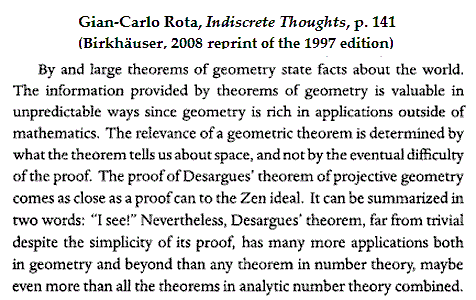
A connection discovered today (April 1, 2013)—
(Click to enlarge the image below.)
Update of April 18, 2013
Note that Baker's Desargues-theorem figure has three triangles,
ABC, A'B'C', A"B"C", instead of the two triangles that occur in
the statement of the theorem. The third triangle appears in the
course of proving, not just stating, the theorem (or, more precisely,
its converse). See, for instance, a note on a standard textbook for
further details.
(End of April 18, 2013 update.)
Update of April 14, 2013
See Baker's Proof (Edited for the Web) for a detailed explanation
of the above picture of Baker's Desargues-theorem frontispiece.
(End of April 14, 2013 update.)
Update of April 12, 2013
A different figure, from a site at National Tsing Hua University,
shows the three triangles of Baker's figure more clearly:
(End of update of April 12, 2013)
Update of April 13, 2013
Another in a series of figures illustrating
Desargues's theorem in light of Galois geometry:

See also the original Veblen-Young figure in context.
(End of update of April 13, 2013)
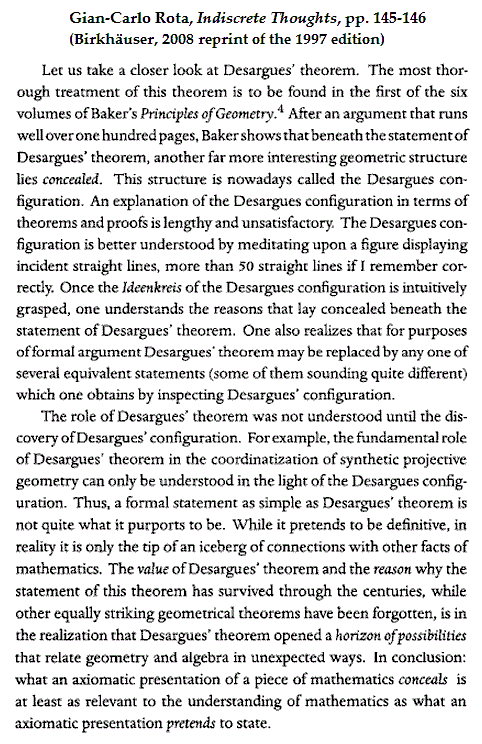
Rota's remarks, while perhaps not completely accurate, provide some context
for the above Desargues-Rosenhain connection. For some other context,
see the interplay in this journal between classical and finite geometry, i.e.
between Euclid and Galois.
For the recent context of the above finite-geometry version of Baker's Vol. I
frontispiece, see Sunday evening's finite-geometry version of Baker's Vol. IV
frontispiece, featuring the Göpel, rather than the Rosenhain, tetrads.
For a 1986 illustration of Göpel and Rosenhain tetrads (though not under
those names), see Picturing the Smallest Projective 3-Space.
In summary… the following classical-geometry figures
are closely related to the Galois geometry PG(3,2):
|
Volume I of Baker's Principles has a cover closely related to the Rosenhain tetrads in PG(3,2) |
Volume IV of Baker's Principles has a cover closely related to the Göpel tetrads in PG(3,2) |
|
Foundations (click to enlarge)
|
Higher Geometry (click to enlarge)
|
"First published between 1922 and 1925,
the six-volume Principles of Geometry was
a synthesis of Baker's lecture series on geometry…."
From a different university press, a new logo
can be seen either as six volumes or as
the letter H —

"What is the H for?"
"Preparation."
Baker, Principles of Geometry, Vol. IV (1925), Title:

Baker, Principles of Geometry, Vol. IV (1925), Frontispiece:

Baker's Vol. IV frontispiece shows "The Figure of fifteen lines
and fifteen points, in space of four dimensions."
Another such figure in a vector space of four dimensions
over the two-element Galois field GF(2):

(Some background grid parts were blanked by an image resizing process.)
Here the "lines" are actually planes in the vector 4-space over GF(2),
but as planes through the origin in that space, they are projective lines .
For some background, see today's previous post and Inscapes.
Update of 9:15 PM March 31—
The following figure relates the above finite-geometry
inscape incidences to those in Baker's frontispiece. Both the inscape
version and that of Baker depict a Cremona-Richmond configuration.

An earlier (noon) version of this post showed a photo of a
heartbreakingly beautiful young woman I encountered on
the Web today by chance. Perhaps it is best if she remains
anonymous here.
A detail taken today from her Facebook page:

Location of a nightclub in Bucharest
Related material: Shining Forth by myself and Malcolm Lowry,
and Lucifer by Mihai Eminescu.
See also this journal "about 3 weeks ago."
Harrowing of Hell (Catholic Encyclopedia )
"This is the Old English and Middle English term
for the triumphant descent of Christ into hell (or Hades)
between the time of His Crucifixion and His Resurrection,
when, according to Christian belief, He brought salvation
to the souls held captive there since the beginning of the world."
Through the Blackboard (Feb. 25, 2010)—
See also The Dreaming Jewels and Colorful Tale.
See Jung on Archetypes and The Innermost Kernel.
For some backstory, see Christmas Eve, 2012.
In Memoriam
"In the late ’60s, Williams became a friend and confidant
of science fiction writer Philip K. Dick and wrote about
the iconoclastic author in Rolling Stone in 1974.
Williams eventually completed a biography on Dick
and became his literary executor after the writer’s death
in 1982. He also edited The Complete Stories of
Theodore Sturgeon, Vol. I-XII ."
— Yesterday in the Hollywood Reporter —
Pioneering Rock Journalist Paul S. Williams Dies at 64
4:06 PM PDT 3/28/2013 by Mitch Myers
See also Crawdaddy Story and The Dreaming Jewels
in this journal.
Related reading: Yesterday's noon post and Puzzles.
Update of 8:20 AM Good Friday, 2013:
For some images related to this rather biblical topic,
see Hillman + Dream in this journal.
“She was dazzled by light and shade, by the confusing
duplication of reflections and of frames. All coming from
too many directions for the mind to take account of.
The various images bounced against each other
until she felt a desperate vertigo….”
Summary image:

“… Margaret Murry, wrapped in an old patchwork quilt, sat on the foot of her bed….”
The title is from a New York Times article
by Roberta Smith on the Barnes collection
(see previous post):
“Nearly every room is an exhibition
unto itself— a kind of art wunderkammer,
or cabinet of curiosities….”
Another sort of Wunderkammer:

Shown above is a Google image search today for Göpel tetrads .
The selected detail is an Oct. 7, 2011, image search
for claves regni caelorum escher (2 MB).
"It should be emphasized that block models are physical models, the elements of which can be physically manipulated. Their manipulation differs in obvious and fundamental ways from the manipulation of symbols in formal axiomatic systems and in mathematics. For example the transformations described above, in which two linear arrays are joined together to form one array, or a rectangle of blocks is re-assembled into a linear array, are physical transformations not symbolic transformations. …"
— Storrs McCall, Department of Philosophy, McGill University, "The Consistency of Arithmetic"
"It should be emphasized…."
OK:

Storrs McCall at a 2008 philosophy conference .
His blocks talk was at 2:50 PM July 21, 2008.
See also this journal at noon that same day:
Froebel's Third Gift and the Eightfold Cube
"… the primal ground of this 'one' is 'nothing.'
The elucidation of the generative matrix of the
myth-work is thus completed…." — Jadran Mimica
Related material— The Nothing That Is.
See Lines of Symbols in this journal.
"… potential recruits with the right skills
have too often been heading for business,
and those who do choose government work
often go to the National Security Agency…."
Review: Einsatz in this journal—
The German title of "The Recruit" (released Jan. 31, 2003)
is "Der Einsatz." Its MacGuffin is "'Ice 9."
Monolith for Maggie, continued from yesterday
"The young woman counted—
'Otu, abua, ato, ano, ise, isii, asaa'—
using what remained to her of
the secret language…."
— Opening sentence of the prologue to The Choir Boats,
a 2009 novel by Daniel A. Rabuzzi
The piano link in today's previous post suggests a review
of a post from Feb. 11, 2008. That post suggests in turn
a passage from the Trevanian classic The Eiger Sanction
that says, in part…
"Often it was unnecessary to finish a sentence…."
(Damnation Morning, continued)
For the late, great Bebo Valdés, who
reportedly died on Friday in Stockholm:
"Mr. Valdés never returned to Cuba. He played piano
in Stockholm hotel lounges for more than three decades."
— Ben Ratliff in this morning's New York Times
Quoted in the March 13 post Blackboard Jungle:
"Every morning you take your machete into the jungle
and explore and make observations, and every day
you fall more in love with the richness and splendor
of the place."
— Paul Lockhart, A Mathematician's Lament
More from Lockhart's jungle—
|
Mathematical objects, even if initially inspired by some aspect of reality (e.g., piles of rocks, the disc of the moon), are still nothing more than figments of our imagination. Not only that, but they are created by us and are endowed by us with certain characteristics; that is, they are what we ask them to be…. … in Mathematical Reality, because it is an imaginary place, I actually can have pretty much whatever I want…. The point is that there is no reality to any of this, so there are no rules or restrictions other than the ones we care to impose…. Make up anything you want, so long as it isn’t boring. Of course this is a matter of taste, and tastes change and evolve. Welcome to art history! — Lockhart, Paul (2009-04-01). A Mathematician's Lament: How School Cheats Us Out of Our Most Fascinating and Imaginative Art Form (pp. 100-104). Bellevue Literary Press. Kindle Edition. |
Related material in this journal: Bellevue and Wechsler.
See also Gombrich in this journal and in the following:
Related material (Click for some background.) —
“Upon the death of the owner, the cloth
may be used to construct a symbolic
Ekpe house (the spirit meeting place)
for the funeral.”
— Lowe Art Museum, University of Miami
“I cannot yet find meaning in this story.”
— Arrow of God (1964)
An update to Rosenhain and Göpel Tetrads in PG(3,2)
supplies some background from
Notes on Groups and Geometry, 1978-1986,
and from a 2002 AMS Transactions paper.
The title refers to the post of Monday,
March 18, 2013:
"I mean, where's it going to end?"
— Rosencrantz in The Gospel
According to Tom Stoppard
A tentative answer:
"Never done."
Angels & Demons meet Hudson Hawk
Dan Brown's four-elements diamond in Angels & Demons :

The Leonardo Crystal from Hudson Hawk :

Mathematics may be used to relate (very loosely)
Dan Brown's fanciful diamond figure to the fanciful
Leonardo Crystal from Hudson Hawk …
"Giving himself a head rub, Hawk bears down on
the three oddly malleable objects. He TANGLES
and BENDS and with a loud SNAP, puts them together,
forming the Crystal from the opening scene."
— A screenplay of Hudson Hawk
Happy birthday to Bruce Willis.
|
From Tom Stoppard's play "Rosencrantz and Guildenstern Are Dead"
GUIL: Yes, one must think of the future. |
Related material: Quotes from H. F. Baker in posts from March 2011—
The previous post discussed some tesseract–
related mathematics from 1905.
Returning to the present, here is some arXiv activity
in the same area from March 11, 12, and 13, 2013.
From the prologue to the new Joyce Carol Oates
novel Accursed—
"This journey I undertake with such anticipation
is not one of geographical space but one of Time—
for it is the year 1905 that is my destination.
1905!—the very year of the Curse."
Today's previous post supplied a fanciful link
between the Crosswicks Curse of Oates and
the Crosswicks tesseract of Madeleine L'Engle.
The Crosswicks Curse according to L'Engle
in her classic 1962 novel A Wrinkle in Time —
"There is such a thing as a tesseract."
A tesseract is a 4-dimensional hypercube that
(as pointed out by Coxeter in 1950) may also
be viewed as a 4×4 array (with opposite edges
identified).
Meanwhile, back in 1905…
For more details, see how the Rosenhain and Göpel tetrads occur naturally
in the diamond theorem model of the 35 lines of the 15-point projective
Galois space PG(3,2).
See also Conwell in this journal and George Macfeely Conwell in the
honors list of the Princeton Class of 1905.
For readers of The Daily Princetonian :
(From a site advertised in the
Princetonian on March 11, 2013)
For readers of The Harvard Crimson :
For some background, see Crimson Easter Egg and the Diamond 16 Puzzle.
For some (very loosely) related narrative, see Crosswicks in this journal
and the Crosswicks Curse in a new novel by Joyce Carol Oates.
"There is such a thing as a tesseract."
— Crosswicks author Madeleine L'Engle
MORAN
MOLLOY
"I lived in the garden. I have spoken of a voice
telling me things. I was getting to know it better
now, to understand what it wanted. It did not
use the words that Moran had been taught
when he was little and that he in his turn had
taught to his little one. So that at first I did not
know what it wanted. But in the end I understood
this language. I understood it, I understood it,
all wrong perhaps. That is not what matters.
It told me to write the report. Does this mean
I am freer now than I was? I do not know.
I shall learn. Then I went back into the house
and wrote, It is midnight. The rain is beating on
the windows. It was not midnight. It was not
raining."
— Molloy , by Samuel Beckett
The above excerpts are in memory of some wordplay
in this journal on March 2, of a sneering joke in the
Daily Princetonian on March 11, and of a possible saint
who reportedly died around midnight on the night of
March 13-14.
See also the morning of March 13.
Note, at the end of the Princetonian piece, a comment
worthy of Beckett—
Continued from February 10 .
A phrase from this morning's post:
Abyssus Abyssum Invocat
Illustration:

See also The Red Pill (March 6) and Classroom from Hell (March 7).
For the new Jesuit pope (see previous post)
Now among Log24 posts tagged "Khora" is one
from July 15, 2010, dealing with a book called
Deconstruction in a Nutshell: A Conversation with
Jacques Derrida , edited and with a commentary by
John D. Caputo (Fordham University Press, 1997).
Related material:
"Khora is the felix culpa of a passion for the impossible,
the happy fault of a poetics of the possible, the heartless
heart of an ethical and religious eschatology.
Khora is the devil that justice demands we give his due."
— John D. Caputo, conclusion of "Abyssus Abyssum Invocat :
A Response to Kearney." Caputo's remarks followed
Richard Kearney's "Khora or God?," pp. 107-122 in
A Passion for the Impossible: John D. Caputo in Focus ,
edited by Mark Dooley, State University of New York Press,
Albany, 2003. See "Abyssus " on pp. 123-127.
See also other uses here of the phrase "In a Nutshell."
From a review in the April 2013 issue of
Notices of the American Mathematical Society—
"The author clearly is passionate about mathematics
as an art, as a creative process. In reading this book,
one can easily get the impression that mathematics
instruction should be more like an unfettered journey
into a jungle where an individual can make his or her
own way through that terrain."
From the book under review—
"Every morning you take your machete into the jungle
and explore and make observations, and every day
you fall more in love with the richness and splendor
of the place."
— Lockhart, Paul (2009-04-01). A Mathematician's Lament:
How School Cheats Us Out of Our Most Fascinating and
Imaginative Art Form (p. 92). Bellevue Literary Press.
Kindle Edition.
Related material: Blackboard Jungle in this journal.
See also Galois Space and Solomon's Mines.
… to apprehend
The point of intersection of the timeless
With time, is an occupation for the saint
— Four Quartets

Intersection sign,
courtesy of Donald Knuth
Related material:
The previous post and Fourfold in this journal.
Thanks to University Diaries for her link today to an
excellent Forbes article on management guru Michael Porter.
Related searches (click images to enlarge)—
For some background, see Diamond model in Wikipedia.
The Stewart quoted in Forbes is Matthew Stewart, author of The Management Myth .
Sistine Chapel Smoke
Tromso Kunsthall Mirrors
Background for the smoke image:
A remark by Michelangelo in a 2007 post, High Concept.
Background for the mirrors image:
Note the publication date— Mar. 10, 2013.
For the Garden of Good and Evil
(Click image for some backstory.)
On Cambridge, Massachusetts:
"By all means accept the invitation to hell,
should it come. It will not take you far—
from Cambridge to hell is only a step;
or at most a hop, skip, and jump.
But now you are evading— you are
dodging the issue… after all,
Cambridge is hell enough."
— Great Circle , a 1933 novel by Conrad Aiken
(father of Joan Aiken, who wrote The Shadow Guests )
Powered by WordPress